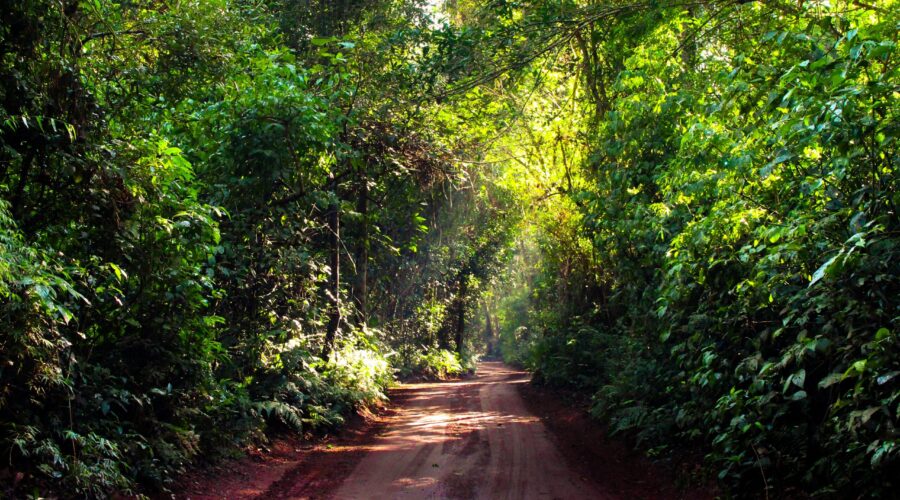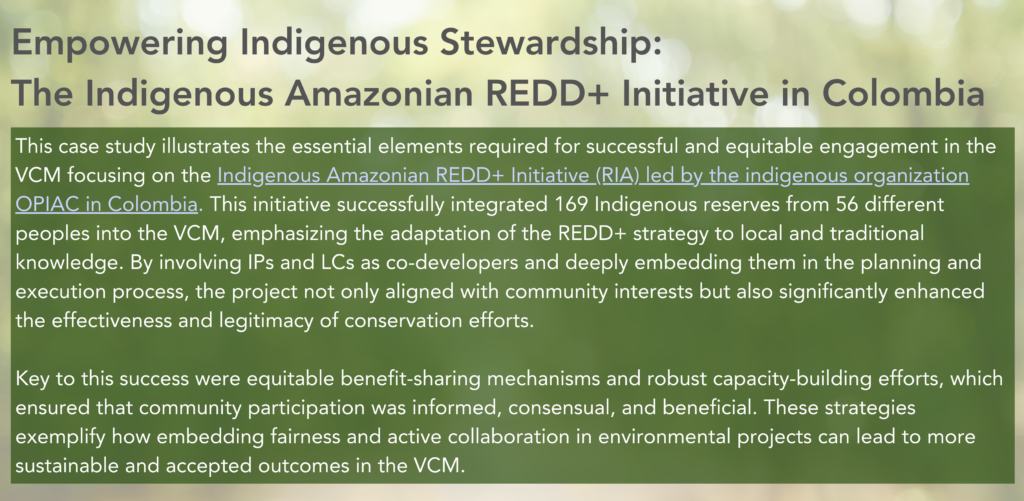As the Voluntary Carbon Market (VCM) expands, it increasingly intersects with the lives and lands of Indigenous Peoples and local communities (IPs and LCs). Public and private entities approach these communities to develop carbon projects on their lands. While some communities explore project development themselves, others find themselves fighting against outside actors developing activities on their land without their consent.
This dynamic presents complex decisions for IPs and LCs over whether and how to engage with carbon market projects and programs that affect their lands. Participation can offer direct access to finance for sustainable land management, but can also risk their land and livelihoods.
Understanding and addressing the opportunities and risks of the VCM
The VCM offers new possibilities for IPs and LCs. Participation in the VCM can lead to direct financial benefits through the sale of carbon credits, which can support community development plans and sustainable livelihoods. VCM participation also has the potential to strengthen land and resource rights through legal recognition, contribute to biodiversity, and enhance local governance. These opportunities can reward communities for their contributions to ecosystem conservation and provide them with tools to actively participate in climate solutions.
However, the VCM also poses considerable risks to communities’ rights to land, use of resources, and territorial governance. Projects that reduce emissions by changing forest or land use practices or local economic activities can violate territorial rights—especially where communities lack formally recognized land tenure—and displace communities or livelihoods. This can lead to conflict between communities and project developers or within communities. Rights violations, displacement, and conflict often stem from failure to obtain the full consent of communities and disregard of local governance practices.
In addition to the risks posed, a challenge for IPs and LCs is that the VCM is technically complex and difficult to navigate for non-experts. This opacity further excludes IPs and LCs, especially as VCM rules and regulations may not be available in their language or presented in a way that communities can use.
Frequently, IPs and LCs are not consulted in the process of developing VCM projects, regulatory frameworks, or grievance mechanisms. Communities struggle to access the potential benefits offered by the VCM as well as to address failures to respect their rights.
A path to equitable engagement and informed decision making
Creating an equitable VCM that provides real benefits to IPs and LCs involves acknowledging their contributions to emissions mitigation and biodiversity protection and empowering them with greater decision-making roles in carbon project development and implementation. Governments and project developers should treat IPs and LCs as equal partners in jurisdictional programs and engage them as co-developers in project planning and execution.
Integrating specific steps into project development and implementation to safeguard the interests and rights of IPs and LCs and to enhance the integrity and effectiveness of the VCM is crucial Free, Prior, and Informed Consent (FPIC) practices ensure continuous and meaningful engagement.
Additionally, capacity-building initiatives provide IPs and LCs with the necessary knowledge to effectively understand and negotiate within the VCM. Transparent and equitable benefit-sharing mechanisms are also essential to ensure that the financial benefits from carbon trading are fairly distributed. Furthermore, it is critical for IPs and LCs to develop an internal strategy before engaging externally to avoid conflicts and maintain community consensus.
A Decision Tool to enhance accessibility of the VCM
Climate Focus, in collaboration with UNDP, recently developed “La Guía de Toma de Decisiones sobre el Mercado Voluntario de Carbono para los Pueblos Indígenas y las Comunidades Locales” (Translation: The VCM Decision Tool for Indigenous Peoples and Local Communities) to make the VCM more accessible to IPs and LCs. This tool provides clear guidance to the VCM, helping IPs and LCs to fully understand the complexities and risks of engaging with the carbon market.
This tool is structured as a framework of questions that communities might ask when faced with decisions about whether and how to participate in the development of a carbon project, and possible answers and approaches to respond. The Decision Tool covers information on
- legal rights,
- benefits and risks of VCM engagement,
- identifying and working with trustworthy partners,
- consent,
- grievance mechanisms, and
- how to ensure community consensus.
The Decision Tool also presents case studies showing ways in which carbon projects have positively and negatively impacted communities. See below for one such case study and further reading materials.
The full Spanish language guide is available for download here.
Further Reading
The VCM Primer – Climate Focus
La Guía de Toma de Decisiones sobre el MVC para los Pueblos Indígenas y las Comunidades Locales – Climate Focus
The VCM as a catalyst of climate action beyond public action by governments – Climate Focus
Balancing the needs of stakeholders for a successful voluntary carbon – Climate Focus



